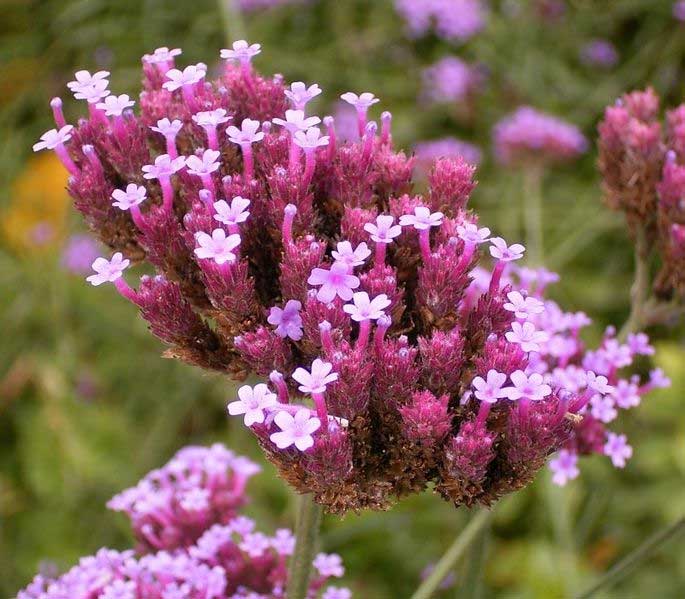
Verbena bonariensis (*)
Classification System: APG IV
Superregnum: Eukaryota
Regnum: Plantae
Cladus: Angiosperms
Cladus: Eudicots
Cladus: Core eudicots
Cladus: Asterids
Cladus: Lamiids
Ordo: Lamiales
Familia: Verbenaceae
Tribus: Verbeneae
Genus: Verbena
Sectio: V. sect. Verbenaca
Series: V. ser. Pachystachyae
Species: Verbena bonariensis
Name
Verbena bonariensis L., Sp. Pl. 1: 20. 1753.
References
Linnaeus, C. 1753. Species Plantarum. Tomus I: 20. Reference page.
Vernacular names
English: purpletop vervain, clustertop vervain, tall verbena, pretty verbena
suomi: Jättiverbena
français: Verveine de Buenos-Aires
日本語: ヤナギハナガサ, サンジャクバーベナ
Nederlands: Argentijnse IJzerhard, IJzerhard, Stijf IJzerhard
русский: Вербена буэнос-айресская
Verbena bonariensis, the purpletop vervain, clustertop vervain, Argentinian vervain,[1] tall verbena or pretty verbena, is a member of the verbena family cultivated as a flowering annual or herbaceous perennial plant. In USA horticulture, it is also known by the ambiguous names purpletop (also used for the grass Tridens flavus) and South American vervain (which can mean any of the numerous species in the genus Verbena occurring in that continent). For the misapplication "Brazilian verbena" see below.
It is native to tropical South America where it grows throughout most of the warm regions, from Colombia and Brazil to Argentina and Chile.
Description
Verbena bonariensis is a tall and slender-stemmed perennial. It can grow to 6 ft (180 cm) tall and can spread to 3 ft (90 cm) wide. At maturity, it will develop a woody base. Fragrant lavender to rose-purple flowers are in tight clusters located on terminal and axillary stems, blooming from mid-summer until fall frost. The stem is square with very long internodes. Leaves are ovate to ovate-lanceolate with a toothed margin and grow up to 4 in (10 cm) long.
Etymology
Verbena is derived from Latin, meaning ‘sacred bough’, in reference to the leafy twigs of vervaine (Verbena officinalis) which were historically carried by priests, used in wreaths for druidic rituals, and for medicine. Named by Virgil and Pliny the Elder. The common name, vervaine, comes from the Celtic name, ‘ferfain’.[2]
Its specific epithet bonariensis means ‘from Buenos Aires, Argentina’. ‘Buenos’ means ‘good’ and ‘aires’ means ‘air’ (‘good air’).[2][3]
Taxonomy and systematics
Verbena bonariensis is a member of the South American vervains, which are polyploid and have more than 14 chromosomes. Among these, it is part of a lineage which might also include Verbena intermedia and seems well distant from Verbena litoralis or Verbena montevidensis for example.[4]
Sometimes, the name Verbena brasiliensis, Brazilian verbena or Brazilian vervain, is found for this species.[5] However, this is the result of a mix-up with V. brasiliensis, the "true" Brazilian verbena, which has been erroneously referred to as V. bonariaensis by several botanists.[6]
Subspecies
There are two named subspecies:[7]
Verbena bonariensis subsp. bonariensis L.
Verbena bonariensis subsp. conglomerata Briq.
Cultivation
V. bonariensis is cultivated as an ornamental plant for traditional and drought tolerant and 'pollinator-host' gardens and parks.
It is a perennial, hardy in USDA Zones 7-11. It can be grown as an annual in areas where it is not winter hardy and will bloom in the first year when grown from seed. Its long internodes give it a sparse appearance but allow it to intermingle and coexist with other plants. The flowers which appear in mid- to late summer, are very attractive to butterflies, and provide nectar for native bees and many beneficial garden insects.
This species grows best in a well-drained soil. It prefers full sun to partial shade and needs regular moisture. It has a reputation of rarely being attacked by insect pests, but may be susceptible to powdery mildew. V. bonariensis is commonly grown from seed which germinates readily without pre-treatment, but can also be propagated from herbaceous stem cuttings.
It has gained the Royal Horticultural Society's Award of Garden Merit.[8][9]
Invasive species
V. bonariensis self-seeds readily. This ability has raised concerns that it may become an invasive species and noxious weed in favorable habitats.[10] It has naturalized in a number of southern United States.
Presently, the plant is on the invasive species watchlist for Washington state,[11] naturalized in tropical and southern Africa, temperate Asia, Australia, New Zealand, the United States (including Hawaii), the West Indies, Macaronesia and the Mascarene Islands. According to Pacific Island Ecosystems at Risk, it is considered a weed in Fiji, New Guinea and other South Pacific islands.[12]
Footnotes
BSBI List 2007 (xls). Botanical Society of Britain and Ireland. Archived from the original (xls) on 2015-06-26. Retrieved 2014-10-17.
Gledhill, David (2008). "The Names of Plants". Cambridge University Press. ISBN 9780521866453 (hardback), ISBN 9780521685535 (paperback). pp 74, 399
CalFlora Botanical Names
Yuan & Olmstead (2008)
E.g. USDA (2007)
UDSA (2008a)
ITIS [2000]
"RHS Plant Selector - Verbena bonariensis". Retrieved 7 June 2013.
"AGM Plants - Ornamental" (PDF). Royal Horticultural Society. July 2017. p. 106. Retrieved 5 February 2019.
"Verbena bonariensis Risk". California Invasive Plant Council. 2017-10-15. Retrieved 2020-03-16.
WSNWCB (2007)
Pacific Island Ecosystems at Risk: V. bonariensis
References
Bailey, L.H. (1951): Verbena bonariensis. In: Manual of Cultivated Plants: 840. Macmillan Publishing Company.
"Verbena bonariensis". Integrated Taxonomic Information System. Retrieved August 7, 2008.
"Verbena bonariensis". Germplasm Resources Information Network (GRIN). Agricultural Research Service (ARS), United States Department of Agriculture (USDA). Retrieved 2008-08-07.
"Verbena brasiliensis". Germplasm Resources Information Network (GRIN). Agricultural Research Service (ARS), United States Department of Agriculture (USDA). Retrieved 2008-08-07.
United States Department of Agriculture (USDA) [2008b]: USDA Plants Profile: Verbena bonariensis. Retrieved 2008-AUG-07.
Washington State Noxious Weed Control Board (WSNWCB) (2007): Tall Verbena, Purple Top, Cluster Flower Vervain. Version of 2007-MAR-31. Retrieved 2008-AUG-07.
Yuan, Yao-Wu & Olmstead, Richard G. (2008): A species-level phylogenetic study of the Verbena complex (Verbenaceae) indicates two independent intergeneric chloroplast transfers. Molecular Phylogenetics and Evolution 48(1): 23–33. doi:10.1016/j.ympev.2008.04.004
Retrieved from "http://en.wikipedia.org/"
All text is available under the terms of the GNU Free Documentation License

